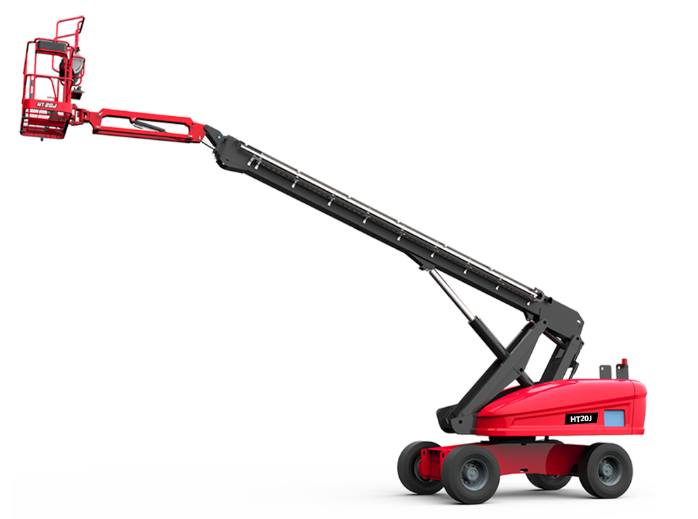Telescopic Boom Truck Advantages VS. Knuckle Boom Cranes
Telescopic truck-mounted cranes, commonly known as boom trucks, are designed to lift materials using a hydraulic winch and by manipulating the boom to raise and lower. Operating these cranes is straightforward: rotate, extend, and adjust the boom as needed.
With the introduction of knuckle boom cranes to the North American market and their established popularity abroad, it's important to understand the differences between these cranes and the benefits that boom trucks offer compared to knuckle boom cranes.
The Winch
Telescopic boom cranes feature a permanently affixed winch, ready for immediate lifting tasks. In contrast, articulated cranes typically use a hook at the tip of the boom for lifting. The winch in a telescopic crane, paired with the crane's rotating and telescoping capabilities, allows for linear movement of loads, simplifying operation. This design is particularly advantageous when handling delicate equipment, as the winch enables precise and gentle placement of loads, irrespective of the lifting radius.
Additionally, the wire rope used with telescopic cranes enhances the accuracy in positioning or lifting loads, which is especially beneficial in industries such as oil and gas and utilities. The primary role of the winch as the lifting mechanism also includes the use of holding valves, which allow heavy loads to be suspended at heights for extended periods without drifting. Knuckle boom cranes are not designed to suspend loads for long periods of time, but for the loading and unloading of materials.
When lifting a load with a telescopic boom, lifting energy goes to the winch first, then to the lift cylinder and crane structure. With a boom truck, adjusting the load to a different radius is typically achieved by raising and lowering the boom rather than extending the boom while the load is suspended. This method reduces the strain on the boom and wear pads compared to a knuckle boom crane, which often requires telescoping while carrying loads during operation.
In knuckle boom cranes, the energy from lifting goes through the boom structure and extension cylinders before reaching the lift cylinder and crane structure. This process leads to greater wear and tear on the boom and extension system over time. Consequently, knuckle boom cranes usually require more maintenance compared to telescopic boom truck cranes, which experience less stress on their components.
The Controls
Boom truck cranes are managed through either a lower control station equipped with manual or electric/hydraulic controls, or via a remote control system. When using the fixed controls, the operator is positioned safely off the ground, either standing at the turret or seated within an enclosed cabin. This elevated position offers optimal visibility of the lifting activities, enhancing operational safety and precision.
In contrast, knuckle boom cranes generally have their lower control station mounted on the side of the turret, necessitating the operator to stand on the ground next to the crane. This ground-level position significantly limits the operator's visibility during crane operations, which can complicate maneuvering and pose additional safety challenges.
The Jib
Telescopic boom lift can be equipped with a telescopic or fixed jib extension, which is both easy to attach and use. This extension can increase the crane boom's reach by up to 55 feet, allowing boom truck cranes to achieve total boom lengths of up to 201 feet. This extended reach is particularly advantageous for placing loads at significant heights or lifting personnel using a work platform.
In contrast, articulated cranes typically have a maximum boom length of around 100 feet. When equipped with a jib extension, a boom truck with a work platform can attain working heights of up to 207 feet (65 meters). Additionally, the jib on boom trucks is conveniently stored on the side of the boom when not in use and can be detached as needed.
The Work Platform
Telescopic boom trucks simplify the process of lifting personnel with a work platform, providing smooth and direct movements by simply raising the boom and extending it. These cranes can achieve working heights of up to 207 feet or more, offering a very stable and comfortable ride.
In comparison, aerial work platforms on knuckle boom cranes attach to the tip of the boom, which can result in a less stable experience due to the non-linear movement of the crane. This can make the ride feel shaky and less secure.
Telescopic boom truck cranes provide a comparable working height to some of the larger European aerial work platforms but typically come at a much more affordable price.
Durability and Climate Protection
The enclosed boom design of boom trucks offers significant protection for sensitive hydraulic cylinders and components from environmental factors like sun, dust, heat, and moisture. This protective design leads to a longer lifespan for these components, as they are less exposed to potential damage.
In contrast, knuckle boom cranes often have multiple exposed cylinders on the boom, which can be problematic in harsh environments. Additionally, most boom trucks with capacities over 30 tons come with enclosed operator cabins equipped with heating and air conditioning, safeguarding the operator from extreme weather conditions. Knuckle boom cranes, however, are usually operated from the ground or via remote control, without the added climate protection.
Ease of Service and Training
Telescoping a load with a knuckle boom crane places more wear on the boom compared to a telescopic crane, which typically involves lifting and lowering the boom with the load rather than extending it. This reduced friction on the boom during operation means that telescopic cranes generally incur lower servicing and ownership costs over time.
The complexity of operating a knuckle boom crane, due to its intricate controls and boom movements, requires several days of training for operators. In contrast, telescopic boom truck cranes are easier to operate, resulting in simpler and quicker training. This ease of operation also makes it easier to train and replace operators throughout the equipment’s lifecycle.
Overall, telescopic boom trucks offer long-term advantages over knuckle boom cranes. If you are considering purchasing, leasing, or renting a boom truck in the near future, you might find our financing guide helpful. Download it below for more information.





